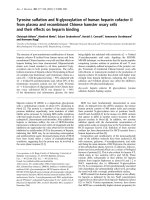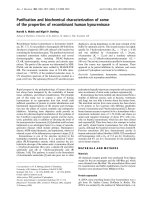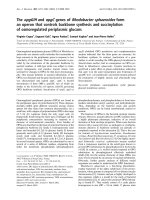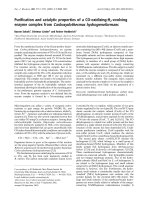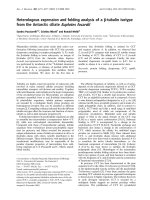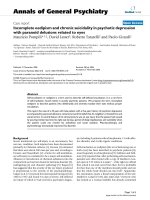Báo cáo y học: "Circulating cytokines and outcome prediction of burned children with concomitant inhalation injury" pdf
Bạn đang xem bản rút gọn của tài liệu. Xem và tải ngay bản đầy đủ của tài liệu tại đây (41.53 KB, 3 trang )
Page 1 of 3
(page number not for citation purposes)
Available online />Abstract
Being able to accurately predict probability of death is important
for the intensivist. Serum cytokine levels parallel physiological
derangements observed in critically ill patients and are used in
commonly applied scoring systems and prediction models. Thus,
serum cytokine based prediction models of outcome seem to be
reasonable and of great interest. In this issue of Critical Care,
Gauglitz and colleagues present their prediction equation for
paediatric burn patients with concomitant inhalation injury. They
found that IL-10 on admission, or IL-6 and IL-7 five to seven days
later, may predict outcome in an excellent way. Increased mortality
is observed as serum IL-6 and IL-10 levels increase and serum IL-7
levels decrease. However, the complexity of cytokine kinetics in
critically ill patients and the variety of factors capable to affect
circulating cytokines even in a subgroup of critically ill patients may
affect the valitidy of the results. Also, serum cytokine based
prediction models need to be compared to commonly applied
prediction models based on clinical parameters. This will enable
identification of the most suitable, accurate, cheapest, and easiest
to use model to predict outcome.
In this issue of Critical Care, Dr Gauglitz and colleagues [1]
present their prediction equation for outcome of burned
children with concomitant inhalation injury based on serum
cytokine measurements.
Prediction of outcome is very important in the intensive care
unit (ICU) and, for this purpose, intensivists have created
illness severity scores (Acute Physiology and Chronic Health
Evaluation (APACHE), Simplified Acute Physiology Score
(SAPS), and Mortality Probability Model (MPM)). These
scores are calculated from data collected on the first ICU day
and comprise two parts: the score itself, reflecting illness
severity; and a probability model, which is an equation giving
the probability of hospital death [2]. Accordingly, illness
severity scores applicable for paediatric populations are
widely used to assess severity and estimate probability of
death [3,4].
The probability of death after burns can be easily predicted
on the basis of simple, objective clinical criteria: age greater
than 60 years; more than 40% of body-surface area burned;
and inhalation injury [5]. With regard to burn injury in children,
only demographics and injury variables have been used to
predict outcome [6,7]. In the later of these studies, an effort
to take into account the effects of treatment on several
variables to predict outcomes was attempted [7].
The activation of the host immune system and the release of
inflammatory mediators have been linked to physiological
derangements observed in burn injury and other inflammatory
conditions, increasing according to illness severity and the
progression of systemic inflammatory response syndrome to
multiple organ failure. Thus, it has been assumed that
increased physiological responses parallel the intensity of
cytokine production and the development of multiple organ
failure and death. Since the production or depression of
several cytokines is related to physiological derangements
commonly used in scoring systems, it seems reasonable to
measure these circulating cytokines and use them as an
additional tool to predict outcome.
In this regard, the article by Gauglitz and colleagues is
original and of great interest [1].
The authors present their data on severely burned children
with concomitant inhalation injury. They found that children
who did not survive had the worst clinical characteristics,
including lower PaO
2
/FiO
2
ratios (arterial oxygen partial
pressure/fraction of inspired oxygen), higher positive
Commentary
Circulating cytokines and outcome prediction of burned children
with concomitant inhalation injury
Pavlos M Myrianthefs and George J Baltopoulos
Athens University School of Nursing ICU at “KAT” Hospital, Nikis St, Kifissia, 14561, Greece
Corresponding author: Pavlos M Myrianthefs,
Published: 23 June 2008 Critical Care 2008, 12:155 (doi:10.1186/cc6920)
This article is online at />© 2008 BioMed Central Ltd
See related research by Gauglitz et al., />ARDS = acute respiratory distress syndrome; FiO
2
= fraction of inspired oxygen; ICU = intensive care unit; IL = interleukin; PaO
2
= arterial oxygen
partial pressure; PIP = positive inspiratory pressure.
Page 2 of 3
(page number not for citation purposes)
Critical Care Vol 12 No 3 Myrianthefs and Baltopoulos
inspiratory pressure (PIP), increased length of ventilator days
and increased acute respiratory distress syndrome (ARDS)
incidence. They also found that among 18 serum cytokines
tested, IL-4, IL-6 and IL-13 were significantly higher on
admission in non-survivors. Also, IL-10 was significantly
higher on admission and on day 5 in non-survivors. On the
other hand, non-survivors showed significantly lower IL-7
serum levels five to seven days post admission when
compared to the survivor group.
Most importantly, using multiple logistic regression analysis,
they created mortality prediction equations of burned children
with concomitant inhalation injury using three serum cytokine
values. They found that IL-10 level on admission, or IL-6 and
IL-7 levels five to seven days later, may predict outcome
when used in these prediction equations. Increased mortality
was observed as serum IL-6 and IL-10 levels increased and
serum IL-7 levels decreased.
This is an excellent work introducing serum cytokine
measurements as indicators of physiological dearrangements
in burned children with concomitant inhalation injury and
using them to predict outcome. However, several issues need
to be discussed.
At first, clinical data for non-survivors (PaO
2
/FiO
2
, PIP, length
of ventilator days, ARDS incidence) were worse compared to
survivors and this parallels cytokine measurements in non-
survivors versus survivors for IL-4, IL-6, IL-7, IL10 and IL-13.
In our opinion, the investigators could also create a prediction
model using easily obtained clinical parameters and without
significant costs for comparisons, or compare their results with
existing scoring systems for illness severity or death prediction
models specifically developed for burn injury that use simple
clinical parameters. Recently, another equation based on a very
large database (68,661 patients) was published, taking into
account seven variables, including age, total body surface area
burned, inhalation injury, co-existing trauma, and pneumonia
[8]. A comprehensive predictive model of burn mortality was
created, providing superior predictive ability compared to
previous models published [6,7].
Another limitation of the study is that it included only a small
number of patients and data from a single institution, which
limit the validity of the results. Also, several other technical
issues need to be clarified, including variability of the cytokine
assays, sample processing, several physiological modifiers of
cytokine production (tissue oxygenation, reactive oxygen
species), and pharmacological modifiers of cytokine
production. All these factors may affect cytokine induction
and, consquently, serum cytokine levels.
Another study [9] in the past tried to correlate illness severity
scores and plasma pro-inflammatory concentrations in
critically ill ICU patients. The authors concluded that plasma
cytokine concentrations fluctuate in serious illness and have a
poor correlation with derangement of whole body physiology
in seriously ill patients. The investigators concluded also that
the daily measurement of plasma cytokine concentrations is
not going to be clinically helpful in the ICU except possibly in
specific subgroups of patients, such as those with sepsis.
However, more recent data suggest that the use of a multiple
cytokine assay platform allows identification of distinct
cytokine profiles associated with sepsis severity, evolution of
organ failure and death [10]. Also, in unselected critically ill
patients, cytokine levels on ICU admission were independent
outcome predictors for the presence and degree of organ
dysfunction [11]. In the subgroup of septic patients, IL-6 was
found to be the sole variable determining outcome. The
authors also wondered whether cytokine measurements
should be introduced in clinical practice for outcome
prediction, and particularly in critically ill septic patients.
Medicine is an evolving science and art interested in death
prediction in the ICU. Since the recognition by Holmes in
1860 [12] that the extent of injury is involved in determining
burn outcome, age and other clinical variables have been
added to better predict outcome [5-8]. Together with
advances in computer science and statistical methods, serum
cytokine measurements may be a new element in predicting
outcome in critically ill patients in the 21st century [1,10,11].
However, we should keep in mind the complexity of cytokine
kinetics in critically ill patients and the variety of factors
affecting circulating cytokines and that serum cytokine based
prediction models need to be compared to commonly applied
prediction models based on clinical parameters. This will
allow us to better identify the most suitable, accurate,
cheapest, and easiest to use model to predict outcome.
Competing interests
The authors declare that they have no competing interests.
References
1. Gauglitz G, Finnerty C, Herndon D, Mlcak R, Jeschke M: Are
serum cytokines early predictors for the outcome of burn
patients with inhalation injuries who do not survive? Crit Care
2008, 12:R81.
2. Le Gall J-R: The use of severity scores in the intensive care
unit. Intensive Care Med 2005, 31:1618-1623.
3. Pollack MM, Ruttimann UE, Getson PR: Pediatric Risk of Mortal-
ity score. Crit Care Med 1988, 16:1110-1116.
4. Slater A, Shann F, Pearson G; Pediatric Index of Mortality (PIM)
Study Group: PIM 2: a revised version of the Paediatric Index
of Mortality. Intensive Care Med 2003, 29:278-285.
5. Ryan C, Schoenfeld D, Thorpe W, Sheridan R, Cassem E, Tomp-
kins R: Objective estimates of the probability of death from
burn injuries. N Engl J Med 1998, 338:362-366.
6. Wolf SE, Rose JK, Desai MH, Mileski JP, Barrow RE, Herndon
DN: Mortality determinants in massive pediatric burns. An
analysis of 103 children with > or = 80% TBSA burns (> or =
70% full thickness). Ann Surg 1997, 225:554-565.
7. Spies M, Herndon DN, Rosenblatt JI, Sanford AP, Wolf SE: Pre-
diction of mortality from catastrophic burns in children. Lancet
2003, 361:989-994.
8. McGwin G Jr, George RL, Cross JM, Rue LW: Improving the
ability to predict mortality among burn patients. Burns 2008,
34:320-327.
Page 3 of 3
(page number not for citation purposes)
9. Friedland JS, Porter JC, Daryanani S, Bland JM, Screaton NJ,
Vesely MJ, Grifin GE, Bennet ED, Remick DG: Plasma pro-
inflammatory cytokine concentrations, Acute Physiology and
Chronic Health Evaluation (APACHE) III scores and survival in
patients in an intensive care unit. Crit Care Med 1996, 24:
1775-1781.
10. Bozza FA, Salluh JI, André M Japiassu AM, Soares M, Assis EF,
Gomes RN, Bozza MT, Castro-Faria-Neto HC, Bozza PT:
Cytokine profiles as markers of disease severity in sepsis: a
multiplex analysis. Crit Care 2007, 11:R49-56.
11. Dimopoulou I, Orfanos S, Kotanidou A, Livaditi O, Giamarellos-
Bourboulis E, Athanasiou C, Korovesi I, Sotiropoulou C,
Kopterides P, Ilias I, Kanellakopoulou K, Armaganidis A: Plasma
pro- and anti-inflammatory cytokine levels and outcome pre-
diction in unselected critically ill patients. Cytokine 2008, 41:
263-267.
12. Holmes T: A System of Surgery, Theoretical and Practical.
London: JW Parker; 1860.
Available online />



